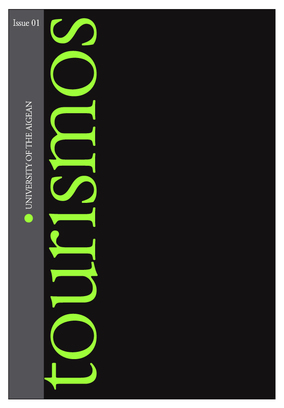The USA’s international travel demand and economic growth in turkey : a causality analysis: (1990 – 2008)
Part of : Tourismos : an international multidiciplinary journal of tourism ; Vol.7, No.1, 2012, pages 235-251
Issue:
Pages:
235-251
Section Title:
Research papers
Author:
Abstract:
This paper investigates the relationship between the USA international travel demand and Turkey’s economic growth over the period 1990-2008. A vector error correction model is employed to test for Granger causality in the presence of co integration between variables. In this study, the impact of the USA international traveler in the Turkish tourism sector is investigated and evaluated by using ADF test, Co-integration approach, and Granger Causality test. The empirical findings indicate a long-run equilibrium relationship and a further uni-directional causality between the two variables.
Subject (LC):
Keywords:
international travel demand, economic growth, ADF, co-integration, causality
Notes:
Περιέχει σχήματα, πίνακες και βιβλιογραφία
References (1):
- Akan, Y., Arslan, I. & Işık, C. (2008). The Impact of Tourism on Economic Growth: The Case of Turkey. Journal of Tourism, Vol. 9, No.2, pp. 47-69.Asafu-Adjaye. (2000). The Relationship Between Energy Consumption, Energy Prices And Economic Growth: Time Series Evidence From Asian Developing Countries. Energy Econ., 22.Balaguer & Cantavella-Jorda, L. (2002). Tourism as A Long-Run Economic Growth Factor: The Spanish Case. Applied Economics, No.34, pp.877-884.Dickey, D.A. & Fuller, W.A. (1979). Distribution of The Estimators For Autoregressive Time Series With A Unit Root. Journal Of The American Statistical Association, No.74, pp. 427-431.Dieke, P.U.C. (2004). Tourism in Africa’s Economic Development: Policy Implication. Management Decision, Vol. 41, No.3, pp.287-295.Dritsakis, N. (2004). Tourism As A Long-Run Economic Growth Factor: An Empirical Investigation For Greece Using Causality Analysis. Tourism Economics, Vol. 10, No.3, pp.305-316.Durbarry, R. (2002). The Economic Contribution of Tourism in Mauritius. Annals of Tourism Research, Vol. 29, No.3, pp.862-865.Engle, R.F. & Granger, C.W.J. (1987). Cointegration and Error Correction: Representation, Estimation and Testing. Econometrica, No.50, pp.987-1007.Eugenio-Martin, J.L. & Morales, N.M. (2004). Tourism and Economic Growth In Latin American Countries: A Panel Data Approach, Social Science Research Network Electronic Paper, Nota De Lavoro 26, 2004. Http://ssrn.com/abstract=504482.Fayissa, B., Nsiah, C. & Tadasse B. (2007). The Impact of Tourism on Economic Growth and Development in Africa. Department Of Economics and Finance Working Paper Series, Murfreesboro, TN 37132.Ghali, A. (1976). Tourism and Economic Growth: An Empirical Study, Economic Development and Cultural Change, No.24, pp.527-538.Granger, C.W.J. (1969) Investigating Causal Relations by Econometric Models and Cross Spectral Methods. Econometrica, No.37, pp.424-438.Gunduz, L. & Hatemi A. (2005). Is The Tourism-Led Growth Hypothesis Valid For Turkey? Applied Economics Letters, No.12, pp.499-504.Johansen, S. (1988). Statistical Analysis of Cointegrating Vectors. Journal of Economic Dynamics and Control, No.12, pp.231-254.Johansen, S. & Juselius, K. (1990). Maximum Likelihood Estimation And Inference On Co-Integration With Applications To The Demand For Money. Oxford Bulletin Of Economics And Statistics, Vol. 52, No.3, pp.169-210.Johansen, S. (1991). Estimation and Hypothesis Testing of Cointegration Vectors in Gaussian Vector Autoregressive Models. Econometrica, No.59, pp.1551-1580.Judge, G.G., Griffiths, W.E., Hill, R.C., Lutkepohl, H. & Lee, T.C. (1985). The Theory and Practice of Econometrics, 2nd ed. Wiley, New York.Katircioglu, S.T. (2009). Revisiting The Tourism-Led-Growth Hypothesis For Turkey Using The Bounds Test and Johansen Approach For Cointegration. Tourism Management, Vol. 30, No.1, pp.17-20.Kim, Hyun Jeong-Ming-Hsiang Chen & Soo Cheong “Shawn” Jang. (2006). Tourism Expansion and Economic Development: The Case of Taiwan. Tourism Management, No.27, pp.925-933.Lanza, A., Templec, P. & Urgad, G. (2003). The Implications of Tourism Specialization in the Long-run: An Econometric Analysis for 13 OECD Economies. Tourism Management, No.24, pp.315-321.Lee, C. & Kwon, K. (1995). Importance of Secondary Impact of Foreign Tourism Receipts on the South Korean Economy. Journal of Travel Research, No.34, pp.50-54.Lee, C.C. & Chang, C.P. (2008). Tourism Management, No.29, pp.180-192.Manuel V. & Robertico C. (2007). Tourism, Economic Expansion and Poverty in Nicaragua: Investigating Co-integration and Causal Relations, staff paper: 07–10.Narayan, P.K. (2004). Economic Impact of Tourism on Fiji’s Economy: Empirical Evidence from the Computable General Equilibrium Model. Tourism Economics, Vol. 10, pp.419-433.Oh, Chi-Ok. (2005). The Contribution of Tourism Development to Economic Growth in the Korean Economy, Tourism Management, Vol. 26, pp.39-44.Ongan, S. & Demiroz, D.M. (2005) The contribution of tourism to the long-run Turkish economic growth. Ekonomický časopis, Journal of Economic, Vol. 53, No.9, pp.880-894.Phillips, P. & Perron, P. (1988). Testing for a Unit Root in Time Series Regression. Biometrica, Vol. 75, pp.333-346.Sinclair, M.T. (1998). Tourism and Economic Development: A survey. The Journal of Development Studies, Vol. 34, pp.1-51.Uysal, M. & Crompton J.L. (1985). Deriving a Relative Price Index for Inclusion in International Tourism Demand Estimation Models. Journal of Travel Research, Vol. 24, pp.32-34.Uysal, M. & Crompton, J.L. (1985). An Overview of Approaches Used to Forecast Tourism Demand. J. Of Travel Research, Vol. 23, No.4, pp.7-15.Vanegas Sr.V. & Croes R. (2007). Tourism, Economic Expansion and Poverty in Nicaragua: Investigating Co-integration and Causal Relations. Staff Paper, pp.7-10.




